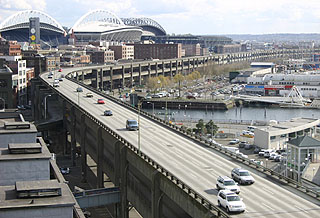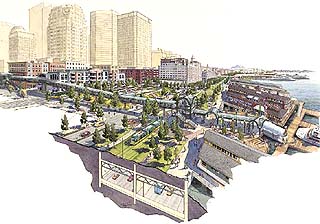|
Subscribe / Renew |
|
|
Contact Us |
|
| ► Subscribe to our Free Weekly Newsletter | |
| home | Welcome, sign in or click here to subscribe. | login |
Architecture & Engineering
| |
October 20, 2004
How will we pay to rebuild or tunnel viaduct?
Journal Staff Reporter

Photo by Sam Bennett
The two top options for replacing the viaduct — building a new viaduct or sending six lanes of traffic underground — are estimated to cost between $3.2 billion and $4.1 billion.
|
Debate on the future of the decrepit Alaskan Way Viaduct has largely focused on whether an elevated highway or a new tunnel will better serve Seattle's competing needs for efficient transportation and a livable, attractive downtown.
How to pay for what would be one of the most expensive public works projects in the state's history has gotten less attention.
The two officially favored options for replacing the Viaduct — building a new viaduct or sending six lanes of traffic underground to reconnect downtown to the Seattle waterfront — are estimated to cost between $3.2 billion and $4.1 billion.
"I think that the numbers are so big that nobody seems to be able to get their hands around them," said Richard Conlin, chair of the Seattle City Council's Transportation Committee.
Officials said the emphasis on design — not fundraising — is the normal sequence of events for a major public works project.
"What's hard to do is pursue funds when you haven't picked an alternative," said Maureen Sullivan, Viaduct project director for the Washington State Department of Transportation.
|
City and state officials recognize that the project is simply too large to be paid for by any one source. They've started identifying potential pots of money at the local, regional, state and federal levels.
WSDOT provided a spreadsheet of 14 potential funding sources for the Viaduct to the Daily Journal of Commerce. Its largest line item was "additional state gas tax/other state sources," with values ranging from $400 million to $2 billion.
Raising a billion dollars of new annual revenue statewide would require a 29 cent per gallon gas tax. That tax would be nearly six times higher than the nickel gas tax passed by the state legislature in 2003. The nickel tax is providing $177 million to the viaduct project.
"I have never seen a credible plan that could get you to $4 billion," said Richard Conlin. Any amount higher than $2 billion , he said, "requires you to make some major assumptions about our ability to influence state and federal policy, which I think are very optimistic."
State and city officials have been making the case in Washington, D.C., that the Viaduct is a project of national interest.
"What we in Seattle have been trying to do is position the Viaduct as the poster child for urgent large transportation projects," said Casey Corr, a spokesman for Mayor Greg Nickels. "It carries 25 percent of the north-south cargo through the largest city in the Northwest. It's very easy to grasp at a national level."
‘Megaproject' funding
WSDOT is pinning its hopes for up to $1 billion on a new "megaproject" fund that the U.S. Congress is considering. The megaproject designation might cover projects that, like the viaduct, cost more than $1 billion.
"If this new designation does take place, Seattle wants to be top of their list," said Patrice Gillespie-Smith, chief of staff of the Seattle Department of Transportation.
Local planners have also set their sights on federal emergency relief dollars, since the viaduct is an earthquake-damaged structure, and on $100 million to $350 million from the U.S. Army Corps of Engineers. The Corps might get involved since the project would involve rebuilding a major seawall.
The RTID experience
But this year's experience with the Regional Transportation Investment District shows that counting on taxpayers or politicians to approve major new expenditures is risky business.
The RTID measure, which many elected officials hoped to put on next month's ballot in King, Pierce, and Snohomish counties, would have raised $1 billion for the Viaduct. But the measure's backers withdrew it after polls seemed to indicate little public support for $12 billion worth of new taxes.
Instead, RTID has two advisory, non-binding measures on the ballot in King County, asking voters in general terms whether they would support putting a transportation measure on the ballot next year and which form of tax they would prefer to raise an unspecified amount of funds.
WSDOT still lists the RTID as one of the Viaduct's largest potential pots of money at $1 billion.
Tolls?

Image by J. Craig Thorpe
This idea for redesigning the waterfront shows the viaduct replaced by a tunnel.
|
Government officials are also eyeing other sources, such as charging tolls to use the viaduct or creating a local improvement district to capture any increase in property values from properties near the viaduct. These sources are likely small potatoes compared to new regional, state or federal monies.
"The most we thought we could get over the 20 or so years of the toll was about $100 million," said Maureen Sullivan, "which isn't very much."
In addition, Sullivan said the Viaduct wouldn't work well as an isolated toll road with its numerous on- and off-ramps and the parallel routes that drivers could take to avoid paying any toll.
Richard Conlin has advocated tolls on either a viaduct tunnel or on the city's entire freeway network to pay for the massive project.
The Downtown Seattle Association was one of the groups that testified in support of a six-lane tunnel replacement for the viaduct at Monday night's Seattle City Council town hall meeting. DSA is "encouraging the (state) legislature to help find funding," according to spokeswoman Anita Woo. She said DSA has not looked into any more specific options such as taxes, tolls, or a local improvement district.
Looking for alternatives
"Everyone knows we do not have money to build a highway megaproject," said Cary Moon of the People's Waterfront Coalition. "Shouldn't we be developing a solution we can afford in case we don't get the money?"
Her coalition advocates not replacing the Viaduct but instead implementing aggressive efforts to smooth and reduce traffic downtown, along the lines of San Francisco's experience with not replacing its Embarcadero Freeway. That elevated bayfront freeway was badly damaged by the Loma Prieta quake of 1989 and demolished in 1991.
Where it once stood, a 2.5-mile promenade now runs past a wide-open waterfront with restored historic buildings alongside new construction, including a cruise-ship terminal and the San Francisco Giants' ballpark.
"It is very unrealistic for people to say it's easy to find $4 billion, but it's too hard to think of a way to do things differently," said Richard Conlin.
WSDOT and SDOT planners see replacing the unstable Viaduct as urgent and are pushing ahead to choose a preferred alternative for it this fall.
"We certainly are at the place with a number of facilities, (like state Route) 520, or repaving I-5, it's not a choice do we want to replace or repave them," said Maureen Sullivan. "We have to."


